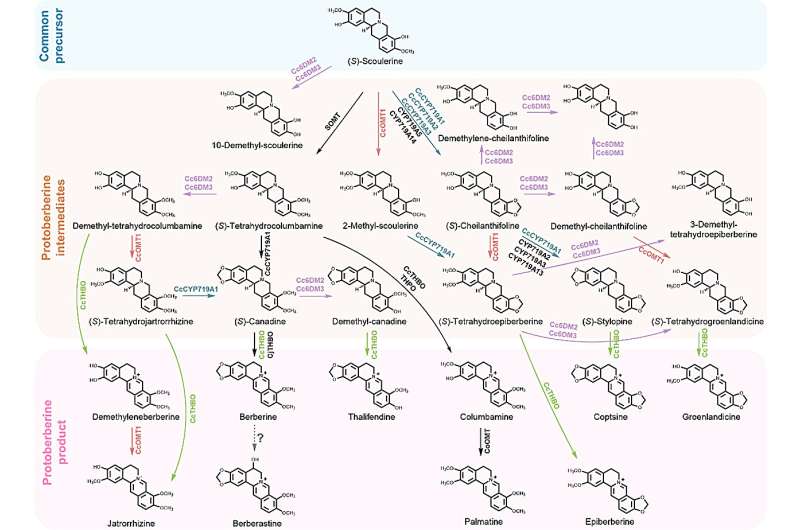This article has been reviewed according to Science X's editorial process and policies. Editors have highlighted the following attributes while ensuring the content's credibility:
fact-checked
peer-reviewed publication
proofread
Elucidating the biosynthetic mechanism for protoberberine alkaloids from Coptis chinensis

Protoberberine alkaloids are a group of tetracyclic isoquinoline compounds known for their well-established antimicrobial and anti-inflammatory properties. Although protoberberine alkaloids are broadly found in various plant families such as Ranunculaceae, Papaveraceae, Berberidaceae, Menispermaceae and Rutaceae, the species of Coptis genus appears to be outstanding producers of protoberberine alkaloids in terms of quantity and diversity.
Still, our knowledge about the physiological role of protoberberine alkaloids in the survival and fitness of Coptis species remains limited. The ecological significance of the lineage-specific prosperity of protoberberine is also unknown. Addressing these questions would require a comprehensive understanding of protoberberine alkaloids biosynthesis.
In a new study, the authors identified CcCYP719A1 from Coptis chinensis that could install methylenedioxy bridge on either ring-A or ring-D of protoberberine backbone, thus diverging metabolite flux towards the biosynthesis of various protoberberine components. They also obtained CcCYP719A2 and CcCYP719A3 that underwent positive selection after diverging from CcCYP719A1 and maintained specific catalytic activity on ring-D.
The study is titled "A biosynthetic network for protoberberine production in Coptis chinensis," and it is published in Horticulture Research.
By identifying CcOMT1, the C-2 O-methyltransferase and CcTHBO, the flavine-dependent oxidase that could catalyze oxidation reaction on ring-C of a wide range of protoberberine biosynthetic intermediate, the authors managed to elucidate the biosynthetic pathway for coptisine and epiberberine.
Further, by identifying two demethylases Cc6DM2 and Cc6DM3, the biosynthetic pathway of jatrorrhizine was finally resolved after years of debate and search for biosynthetic enzymes that could explain the lack of O-methylation on C-3 of jatrorrhizine, which is already present in (S)-scoulerine, the common biosynthetic precursor of protoberberine alkaloids.
These findings demonstrate that the diversity of protoberberine alkaloids does not arise from the actions of specific enzymes dedicated to distinct routes, but is achieved through the collaboration of versatile modifying enzymes. These enzymes catalyze branching reactions from various biosynthetic intermediates, ultimately giving rise to different protoberberine components.
This protoberberine metabolite network holds significant promise for the targeted biosynthesis of protoberberine components and their derivatives in selected chassis cells. It is likely that the actual biosynthetic capacity of C. chinensis has been underestimated, limited substrate availability prevented us from fully evaluating the capacity through in vitro enzyme assays. Taken together, these unidentified protoberberine alkaloids constitute the "dark matter" within the protoberberine repository.
The demethylation and demethylenation activity shown by Cc6DM2 and Cc6DM3 could revert modification on many protoberberine biosynthetic intermediates, allowing them to be redirected and enters into other protoberberine biosynthetic routes. Therefore, the protoberberine demethylases could collaborate with protoberberine O-methyltransferases and modulate the composition of the protoberberine repository through a methylation-demethylation tuning strategy.
By playing dual roles in protoberberine biosynthesis and the composition-tuning process, Cc6DM2 and Cc6DM3 might also constitute an intersection between biosynthesis and regulation. More examples that employ different paradigms of such intersection might be uncovered in the future to provide fresh perspectives on plant specialized metabolism.
More information: Linrui Wu et al, A biosynthetic network for protoberberine production in Coptis chinensis, Horticulture Research (2023). DOI: 10.1093/hr/uhad259
Journal information: Horticulture Research
Provided by Plant Phenomics





















